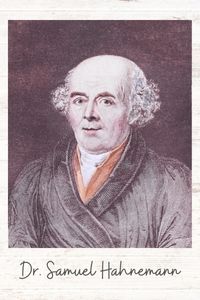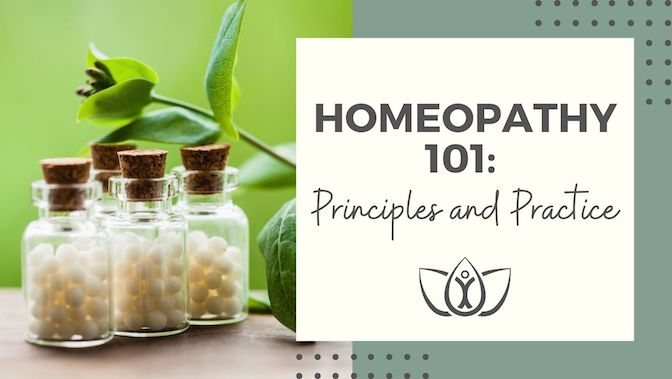This blog post was written by Victoria L. Freeman, Ph.D., CHFS, CMH, CBC.
The highest ideal of therapy is to restore health rapidly, gently, and permanently. ~ Samuel Hahnemann, M.D.
The evening was winding down when “MaryAnn” (name changed to protect her privacy) called Kelly Weatherly, Board Certified Traditional Naturopath and adjunct instructor in the CNHP and CHHP programs at Trinity, to ask her advice on a homeopathic remedy to address food poisoning. “MaryAnn’s” husband and son were both struggling with it. “Do you have Arsenicum album in your homeopathic kit?” Weatherly replied. MaryAnn did have it. Weatherly suggested she give 2 or 3 pellets every 15 minutes for an hour and then call her back. But it didn’t take an hour. In about a half-hour, Weatherly received a text from MaryAnn saying that both her husband and son were eating crackers and feeling much better. It only took two doses!
Restoration stories like this one are not uncommon in the practice of homeopathy. The healthcare system beneath the surface of this brief example is deep and wide, though, and much too complex to explore all aspects of it in one blog article. We can, however, stick our proverbial toes in the water and examine some introductory fundamentals of homeopathy.

In the 1790s, due to his dissatisfaction with the standard practices of medicine, German physician Dr. Samuel Hahnemann introduced and developed a system of natural healthcare he called “homeopathy,” from the Greek term homeo, meaning “similar,” and pathos, meaning “suffering.”4 Hahnemann recognized that when a person becomes ill, the whole person – mind, body, and spirit – is affected. Therefore, with homeopathy, he sought to support the entire person. To that end, homeopathic remedies are designed to holistically stimulate our self-regulating mechanisms to initiate the healing process.6
The Heart of Homeopathy
The foundational principles of homeopathy have remained largely unchanged in the roughly 230 years since its inception, and they include:
· Similia Similbus Curentur, "Let like cure like." Using both research and clinical practice, Hahnemann verified a remedy’s effectiveness through the use of “similars.” That is, “a substance that can produce disease in a healthy person is used to elicit a healing response in someone presenting with a similar disease.”6 Everyone shows symptoms in the body, mind, and spirit when they’re sick. While some of these symptoms are common to that particular illness, others are characteristic of the individual and their manifestation of the illness. A homeopathic practitioner works to match the “symptom picture” of the homeopathic remedy to the symptom picture of the person, with particular attention to those symptoms unique to the individual.6
· The Minimum Dose. “Minimum” refers to the minuscule doses of remedies given as well as to the repetition of doses only when necessary. Allopathic drugs given to individuals can frequently cause side effects or adverse reactions. To curtail this problem, the homeopathic practitioner recommends the smallest possible dose to maximize beneficial effects and minimize side effects. “Repetition of dose is determined by the individual's response to the remedy. Unnecessary repetition may lessen the response, even to the correct remedy. In homeopathy, less is better.”6
· The Potentized Remedy. Homeopathic remedies, though made from natural substances such as plants, minerals, animals, etc., are manufactured unlike any other treatment. Through a process of serial dilution, a very dilute extract is made. With every step of dilution, the remedy is vigorously shaken or succussed (more on this later). This process of dilution and succussion is designed to stimulate the dynamic nature of the remedy, thus making it more potent.6
According to homeopathic philosophy, the body manifests symptoms of illness, but it is not the origin of illness. Rather, the origin is an imbalance of the vital force, which is the essence of a person. Likened to qi in Traditional Chinese Medicine or prana in Ayurveda, the vital force is the energy that keeps an organism alive. Hence, a complete waning of the vital force results in death.6 From a Christian perspective, we consider vital force to be the energy God infused into everything (humans, animals, plants, all of nature) at the time of creation. This vital force or energy that connects mankind and earth plays an integral role in the well-being of both.5 Hahnemann (and homeopaths since him) thought that homeopathic remedies strengthen and protect this vital force energy.
How Do Homeopathic Remedies Work?
How does homeopathy bolster our vital force? Plenty of researchers have attempted to answer this question, but as of yet, no one has definitively. Hahnemann believed in symptom-based healing, which states that in order for the body’s healing mechanisms to be triggered, one must be experiencing symptoms. However, we know that it’s common for a disease process to occur for a prolonged time prior to symptoms. Thus, Hahnemann concluded that giving a homeopathic remedy that mimics the same symptoms as the health condition will stimulate the body’s own response to begin healing sooner and more effectively.
Weatherly agrees but adds that homeopathic remedies “…help the body recognize the frequency it needs to begin healing. We are energetic beings, and homeopathy is energetic healthcare. So, the two resonate well together.” Let’s take the example of two tuning forks, she says. If you have two tuning forks close together, but not touching, and strike one, the other tuning fork will also start ringing. “The additional tuning fork is sort of like our bodies,” she explains. “When we take homeopathic remedies, they give off a frequency, and our bodies will recognize that frequency and start ringing, too. The two will be in harmony.”
Hahnemann “proved” more than 100 remedies in his lifetime, and now there are several thousand remedies in use. A homeopathic “proving” constitutes the database of that substance; the data includes detailed descriptions from several healthy people (men and women) about what symptoms they develop (body and mind) over the course of a few weeks when taking the remedy. It is detailed evidence of what that substance causes in healthy humans. By consulting this database or proving, we can determine what the remedy does from the symptoms it produces.2
Homeopaths state that whatever symptom a remedy can cause, it can also lessen or remove – the “like cures like” principle. Practitioners then consult the proving of a given remedy to see if the symptoms it contains parallels the symptoms of the client. When satisfied that most of the client’s key symptoms correspond to the proving symptoms, practitioners may then recommend the remedy.2
It sounds easy, but it’s not. Of the several thousand homeopathic remedies in common use, many symptoms from the databases overlap with multiple remedies. So, practitioners must use their training, judgment, and experience to select the most beneficial homeopathic remedy, i.e., the one that best corresponds to the client’s symptoms.2
Critics of homeopathy argue that remedies are nothing more than sugar pills doused with alcohol and that any healing that follows is only a placebo effect. Or, they assert that the client would have recovered without any intervention. However, the centuries of success, particularly in children and animals where a placebo effect is not possible, say otherwise.
Even in the scientific research sector, homeopathy has been shown to be effective. A Swedish study that reported on pooled data from 89 clinical trials involving different health conditions testing homeopathy against a placebo found an overall odds ratio of 2.45, which means that those subjects receiving homeopathic remedies were an average of 2.45 times more likely to experience health improvements than those receiving placebos.3 Researchers in another meta-analysis study reported that homeopathy lacks clinical effect, but in order to come to that conclusion, more than 90% of the available clinical trials had to be disregarded.3
It is important to note that one of the reasons why the effectiveness of a homeopathic remedy, or any health-promoting strategy, may be limited is a lack of attention to the foundations of health. We need to tend to the foundations before, or at least in conjunction with, enlisting the help of homeopathic remedies. So, for example, if you’re attempting to support a health condition with homeopathy but you’re deficient in a certain vitamin or mineral that affects the condition, that homeopathic remedy may not accomplish your goal. The problem, however, would not be the remedy in that case. But rather, a more well-rounded diet would be required to remove that obstacle to health.
How Are Homeopathic Remedies Made?
As mentioned previously, remedies are made from plant, animal, and mineral extracts and diluted in varying degrees to avoid unpleasant side effects. Paradoxically, the more dilute remedies are, the more effectively they work.4
For remedies derived from soluble substances, the raw material is dissolved in an alcohol (90%) and distilled water (10%) mixture (exact ratios may vary depending on the substance), left to stand for two to four weeks, shaken occasionally, and then strained through a press. The liquid that results is known as the mother tincture. Insoluble raw materials are first ground until they become soluble, then the process is the same.4
“To produce different remedy potencies, the mother tincture is diluted in an alcohol/water mixture most commonly according to one of two scales, the decimal (x) or the centesimal (c). Between every stage of dilution, the solution is succussed or shaken vigorously.”4 In the decimal scale, the dilution ratio is 1:10; in the centesimal, it is 1:100 (thus the “x” and “c”). So, to produce a 1c potency, for example, one drop of mother tincture is added to 99 drops of the alcohol/water mixture and succussed. To create a 2c potency, one drop of the 1c mixture is added to 99 drops of an alcohol/water mixture and again succussed. “The number of a homeopathic remedy shows how many times it has been diluted and succussed.”4
Once a remedy has been diluted beyond a 12c potency, it’s unlikely that a molecule of the original substance remains. Yet homeopaths believe that remedies contain an “energetic memory” or an “energetic impulse” of their base ingredients, and it’s this “memory” or “impulse” that energetically triggers the body’s innate healing.
Positive Actions of a Well-Chosen Remedy
Weatherly recounts a personal experience with a homeopathic remedy that illustrates how effective they can be and the process through which an appropriate remedy often exerts its actions. In 2015 she entered a store that housed many synthetic flowery scents and immediately started sneezing. Her ears and throat also became itchy. As soon as she left the store, she took a homeopathic remedy called Sabadilla because it most closely matched her symptoms at the time.
Within 10 minutes, her symptoms were gone. However, the symptoms returned just 5 minutes later. After a second dose, the symptoms stopped for 15 minutes. Then after a third dose, the symptoms were at bay for 30 minutes. Following a fourth dose, Weatherly was symptom-free for 2 hours. By the fifth dose, she was able to discontinue the remedy as the symptoms did not return. Future exposures to the same store resulted in a prolonged onset of symptoms, being able to extend the time between doses much longer, and the symptoms, when they did occur, were also less severe. Now it’s rare that she needs the remedy at all when entering the same store.
The process Weatherly experienced when taking Sabadilla demonstrates the actions of a well-chosen remedy:
1. A shortened duration of symptoms
2. A longer period of time possible between doses
3. Lessened severity of symptoms
4. Onset of sleepiness – Sleepiness doesn’t always occur, but it’s not uncommon. Weatherly did not experience sleepiness, but it’s a good sign when it does happen since it indicates the remedy is signaling the body to rest and recover.
What’s the best way to choose an appropriate homeopathic remedy? Many present-day homeopaths suggest remedies based on matching the proving database of symptoms (found in Boericke’s New Manual of Homeopathic Materia Medica with Repertory) as closely as possible with the client’s presenting symptoms. Others, however, work to identify a client’s constitutional makeup (physical and mental characteristics, desires, aversions, personality, and behavioral patterns) and suggest a remedy that most closely supports that constitution. Weatherly says there can be a lot of trial and error in determining a person’s constitutional remedy, and ultimately the process can become frustrating for the client. It may take several attempts to match the individual’s constitution, and in the meantime, the person is still experiencing the problems that drove him or her to seek help in the first place. Her philosophy is to draw from different forms of homeopathy, depending on the needs of a particular client.
Some Popular Homeopathic Remedies
When used appropriately and guided by a trained practitioner, homeopathy is a safe and supportive healthcare system. “There are thousands of homeopathic remedies available today, but we frequently refer to the polychrest remedies that are used the most often,” explains Weatherly. Polychrest remedies are frequently used and have widespread and tried-and-true clinical applications. They cover a wide variety of holistic symptomology. For detailed information on polychrests, see this comprehensive report.
A few common polychrest homeopathic remedies include:
Remedy Partial Indications4
|
Allium cepa |
Burning or neuralgic pain. Complaints with a burning, streaming discharge, especially from the eyes and nose. Symptoms or pains that alternate from side to side, usually left to right. |
|
Arnica montana |
Shock, pain, bruising, and bleeding. Ideal in postoperative care. Also helpful for people who tend to deny illness. |
|
Carbo vegetabilis |
Low vitality and exhaustion. Cold, clammy skin and a hot feeling inside associated with shock. Conditions that affect venous circulation and digestion. |
|
Hepar sulfuris calcareum |
Infections, especially those with pus. Ailments characterized by sharp pains, sour-smelling secretions, and sensitivity to touch, pain, and noise. Sore throat with ear pain upon swallowing. |
|
Kalium phosphoricum |
Physical and mental exhaustion with an associated aversion to company and marked with chilliness. Pus-filled discharges. |
|
Thuja occidentalis |
Warts and other skin complaints. Nail problems. Genitourinary tract conditions. Conditions characterized by yellowish-green or green phlegm. |
Here are some additional remedies that Weatherly recommends and uses frequently.
Remedy Partial Indications1
|
Aconitum napellus |
Fear, anxiety, restlessness, anguish of mind and body. Sudden and great sinking of strength. Inflammations and inflammatory fevers. Influenza. Shocking event, physical or mental. |
|
Arsenicum album |
Debility, exhaustion, restlessness, burning pains, unquenchable thirst. Burning relieved by heat. Injurious effects of fruits, especially watery ones. Fear, fright, and worry. Nausea, vomiting, fever. |
|
Belladonna |
Nervous system conditions, heat, redness, throbbing, burning. Corresponds to “air sickness” in aviators and can be given as a preventive. Heart palpitations. |
|
Bryonia alba |
Irritability. Aching in every muscle, stitching pains aggravated by motion. Acts on all serous membranes and the viscera they contain. Vertigo, nausea, faintness on rising. |
|
Ferrum phosphoricum |
First stage of all febrile and inflammatory conditions prior to exudation. Build-up of mucus in the respiratory tract. Pale, anemic conditions with congestion. |
To learn more about homeopathy, consider these educational programs offered by Trinity: Certified Natural Health Professional, Certified Holistic Health Practitioner, and Certified Clinical Homeopathic Specialist.
References
1. Boericke, W. (2007). Boericke’s New Manual of Homeopathic Materia Medica with Repertory. Third Revised & Augmented Edition based on Ninth Edition. B. Jain Publishers (P) Ltd.: India.
2. Extreme Mysteries. (2022, Oct. 3). Homeopathy Mystery of Healing. https://www.youtube.com/watch?v=0mtHcWhR-z0, downloaded April 1, 2023.
3. Hahn, R.G. (2013). Homeopathy: Meta-Analyses of Pooled Clinical Data, Forschende Komplementarmedizin 20:376-381. (Summary in English, article in Swedish.)
4. Lockie, A. and N. Geddes. (2000). D.K. Natural Health Guide to Homeopathy, 2nd Ed. Dorling Kindersley, Inc.: New York, NY.
5. Weatherly, K. (2020). “The Energy Force Connecting Man, Earth, and Health,” Dissertation paper, Trinity School of Natural Health.
6. (n.a.) (n.d.) Whole Health Now: Your #1 Source for Everything Homeopathic. Homeopathy Info. https://www.wholehealthnow.com/homeopathy_info/, downloaded March 20, 2023.
Resources
1. Americans for Homeopathy Choice
Based in Post Falls, Idaho, Americans for Homeopathy Choice is a non-partisan, national non-profit formed to support the rights of Americans who use homeopathy. They also work to protect access to homeopathy so practitioners can work with clients, and they work to protect manufacturers of homeopathy who meet the standards for strength, quality, and purity. Their website includes multiple resources, including research articles, FAQs, and helpful links.
2. Boericke, W. (2007). Boericke’s New Manual of Homeopathic Materia Medica with Repertory. Third Revised & Augmented Edition based on Ninth Edition. B. Jain Publishers (P) Ltd.: India.
3. Homeopathy Research Institute
Located in London, England, the organization funds and supports homeopathy research in the United Kingdom and overseas. Their website includes research reports on homeopathy, a research database, educational videos, recommended reading, HRI conference presentation videos, and FAQs.
4. National Center for Homeopathy
The National Center for Homeopathy is located in Clarksburg, Maryland and provides education and creates awareness while advocating for access to homeopathy. Membership in the organization provides access to exclusive homeopathy resources. Their website offers free guides, a Materia Medica, access to their newsletter and magazine, other education and resources, and much more.
ABOUT THE AUTHOR:

Victoria L. Freeman, Ph.D., CHFS, CMH, CBC, has traveled a long and winding professional road that includes working as a teenage fine artist, later a personal trainer and wellness coach, a college professor and administrator in exercise science and education, a freelance natural health and fitness writer for national magazines, a property manager and interior designer for vacation and executive rental properties and most recently returning to the natural health arena while attending Trinity School of Natural Health to become a Certified Holistic Fitness Specialist, a Certified Master Herbalist, and a Certified Biblical Coach.


